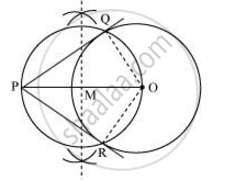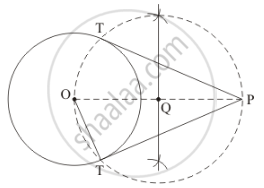Advertisements
Advertisements
Question
Draw a circle of radius 6 cm. From a point 10 cm away from its centre, construct the pair of tangents to the circle and measure their lengths. Give the justification of the construction.
Solution 1
A pair of tangents to the given circle can be constructed as follows.
Step 1
Taking any point O of the given plane as centre, draw a circle of 6 cm radius. Locate a point P, 10 cm away from O. Join OP.
Step 2
Bisect OP. Let M be the mid-point of PO.
Step 3
Taking M as centre and MO as radius, draw a circle.
Step 4
Let this circle intersect the previous circle at point Q and R.
Step 5
Join PQ and PR. PQ and PR are the required tangents.

The lengths of tangents PQ and PR are 8 cm each.
Justification
The construction can be justified by proving that PQ and PR are the tangents to the circle (whose centre is O and radius is 6 cm). For this, join OQ and OR.

∠PQO is an angle in the semi-circle. We know that angle in a semi-circle is a right angle.
∴ ∠PQO = 90°
⇒ OQ ⊥ PQ
Since OQ is the radius of the circle, PQ has to be a tangent of the circle. Similarly, PR is a tangent of the circle.
Solution 2
Given that
Construct a circle of radius 6 cm, and let a point P = 10 cm form its centre, construct the pair of tangents to the circle.
Find the length of tangents.
We follow the following steps to construct the given

Step of construction
Step: I- First of all we draw a circle of radius AB = 6 cm.
Step: II- Make a point P at a distance of OP = 10 cm, and join OP.
Step: III -Draw a right bisector of OP, intersecting OP at Q .
Step: IV- Taking Q as centre and radius OQ = PQ, draw a circle to intersect the given circle at T and T’.
Step: V- Joins PT and PT’ to obtain the require tangents.
Thus, PT and P'T' are the required tangents.
Find the length of tangents.

As we know that OT ⊥ PT and ΔOPT is right triangle.
Therefore,
OT = 6cm and PO = 10cm
In ΔOPT,
PT2 = OP2 - OT2
PT2 = 102 - 62
PT2 = 100 - 36
PT2 = 64
`PT = sqrt64=8`
Thus, the length of tangents = 8 cm.
APPEARS IN
RELATED QUESTIONS
Draw a line segment AB of length 8 cm. Taking A as centre, draw a circle of radius 4 cm and taking B as centre, draw another circle of radius 3 cm. Construct tangents to each circle from the centre of the other circle.
Draw a circle of radius 3 cm. Take a point at a distance of 5.5 cm from the centre of the circle. From point P, draw two tangents to the circle.
Draw a circle of radius 5 cm. Draw two tangents to this circle so that the angle between the tangents is 45°.
Draw an inscribing circle of a regular hexagon of side 5.8 cm.
Construct a triangle ABC in which base BC = 5.5 cm, AB = 6 cm and ∠ABC = 120°.
- Construct a circle circumscribing the triangle ABC.
- Draw a cyclic quadrilateral ABCD so that D is equidistant from B and C.
Draw two tangents to a circle of radius 3.5 cm form a point P at a distance of 6.2 cm form its centre.
Draw a circle of radius 32 cm. Draw a tangent to the circle making an angle 30° with a line passing through the centre.
Draw a circle of radius 4 cm and take a point Pon its circumference. Construct a tangent to the circle at P.
To draw a pair of tangents to a circle which are inclined to each other at an angle of 35°. It is required to draw tangents at the end points of those two radii of the circle, the angle between which is ______.
To draw a pair of tangents to a circle which are inclined to each other at an angle of 60°, it is required to draw tangents at end points of those two radii of the circle, the angle between them should be ______.
